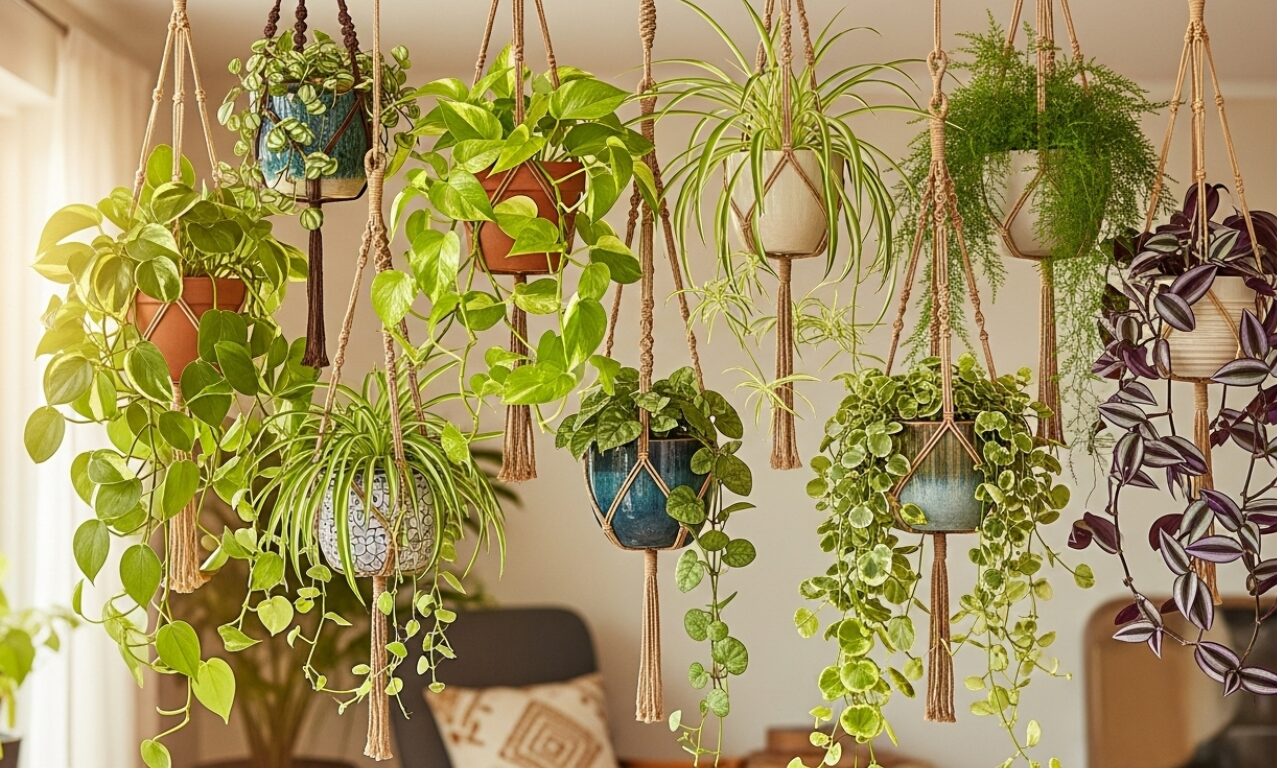When designing your indoor green space, indoor hanging plant pots (aka hanging planters, trailing plant baskets) offer both style and function.
Hanging plants bring vertical interest, make use of ceiling space, and let trailing foliage shine.
In this blog post, I will tell you the best plants for indoor hanging pots, backed by real data, expert sources, and practical care advice.
Why Choose Plants for Hanging Pots?
Before going through the plant list, it’s helpful to understand why certain plants are particularly suited for hanging planters:
Trailing or cascading growth
Many hanging plants naturally grow downwards (e.g., vines, succulents, ferns), creating a flowing, lush look.
Space efficiency
Hanging baskets free up floor and shelf space, making them ideal for small apartments or crowded rooms.
Air purification
Many of these plants help improve indoor air quality.
Aesthetic versatility
From minimalist succulents to boho macramé favourites, hanging planters can match many decor styles.
Top Indoor Plants for Hanging Pots
Here are some of the best choices, including botanical details, care needs, and why they suit hanging pots.
1. Heartleaf Philodendron (Philodendron hederaceum)
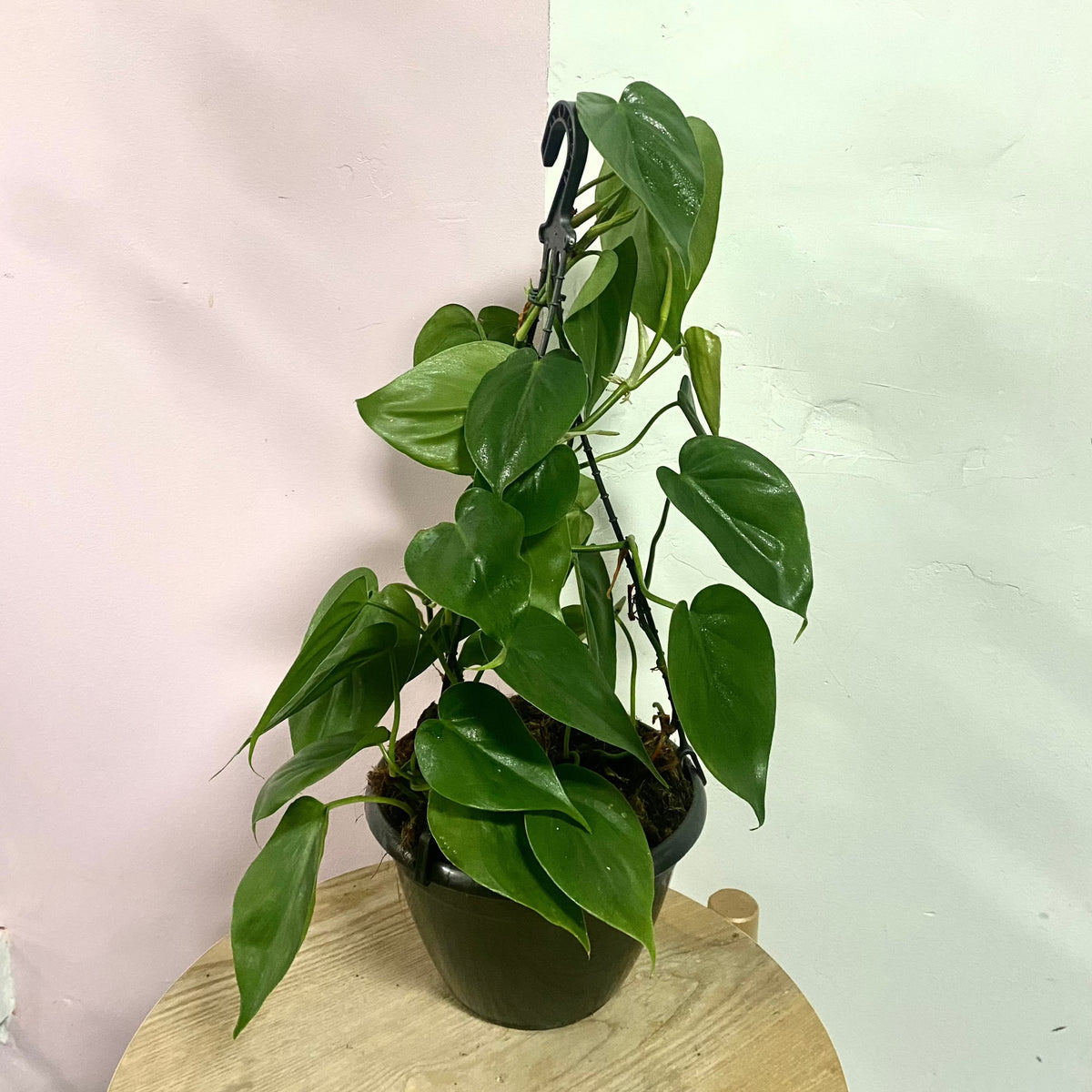
Why it’s ideal: A classic trailing plant, heartleaf philodendron has soft, heart-shaped leaves and a forgiving growth habit. Among philodendron varieties, the heartleaf type is especially popular for hanging.
- Light: Prefers medium to bright, indirect light.
- Water: Let the top inch of soil dry out between watering.
- Growth: Fast-growing and easy to propagate by cuttings.
- Styling tip: Use a simple ceramic or plastic hanging pot to let the long vines drape beautifully.
2. Pothos (Epipremnum aureum)

Why it’s ideal: Pothos is perhaps the most recommended trailing houseplant. It’s durable, fast-growing, and very tolerant of different light conditions. Pothos can grow up to one foot per month in ideal conditions.
- Light: Low to bright indirect light — very adaptable.
- Water: Water when the soil begins to dry; don’t let it sit in soggy soil.
- Propagation: Very simple via stem cuttings in water or soil.
- Styling tip: Use a hanging basket at ceiling height so the vines have room to trail down.
3. Spider Plant (Chlorophytum comosum)

Why it’s ideal: Spider plants are known for their “baby” plantlets (spiderettes) that grow on long stems — perfect for hanging.
- Height / Spread: Leaves grow ~20–60 cm; inflorescences (flower stalks) can trail down up to 75 cm.
- Light: Bright, indirect light, but tolerates lower light.
- Water: Keep evenly moist; avoid letting the plant dry out completely or be waterlogged.
- Special care: When it flowers, the plantlets can root and become new spider plants.
- Styling tip: Trailing spiderettes add a soft, cascading look; use deep hanging pots to accommodate the roots.
4. String of Hearts (Ceropegia woodii)
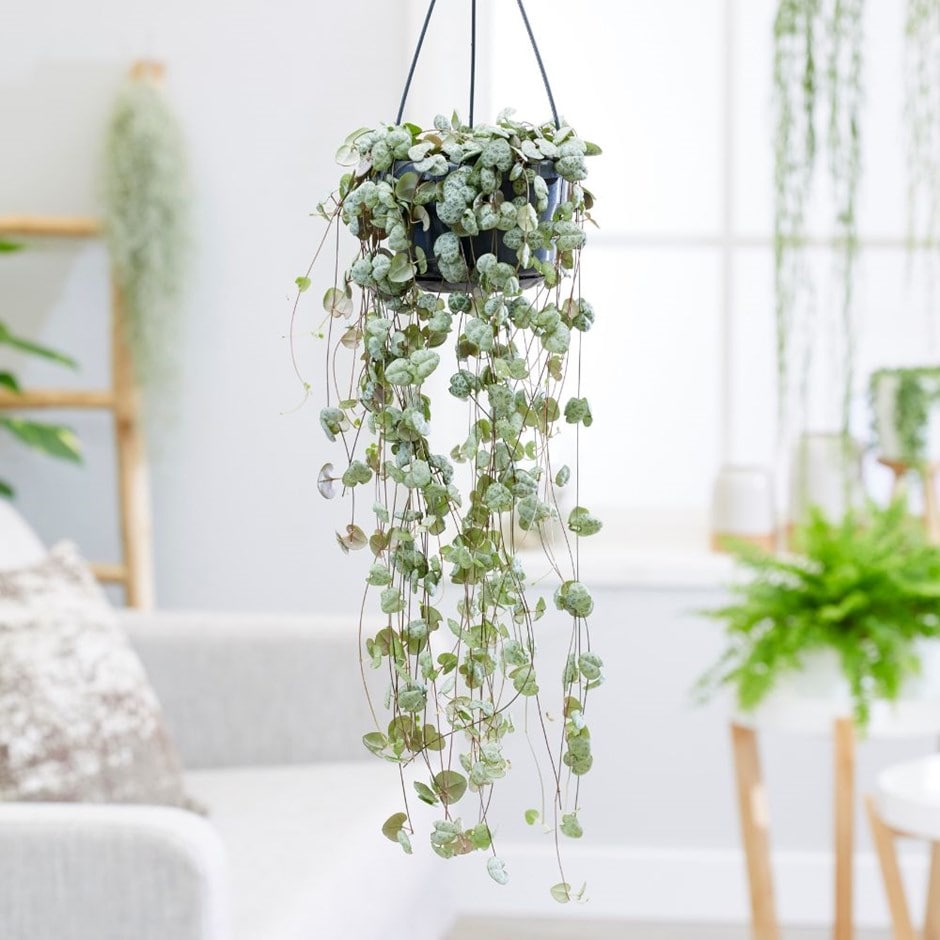
Botanical info: Ceropegia woodii is a delicate, trailing succulent vine with small, heart-shaped leaves.
- Growth: Can reach up to ~2 meters in length in hanging form.
- Light: Needs bright, indirect light — some direct morning light is ideal.
- Water: Very drought-tolerant. Water only when most of the soil is dry.
- Soil: Use a well-draining succulent or cactus mix to avoid root rot.
- Styling tip: Works beautifully in shallow hanging pots or macramé hangers, letting the vine gently drape.
5. Hoya (Hoya carnosa)
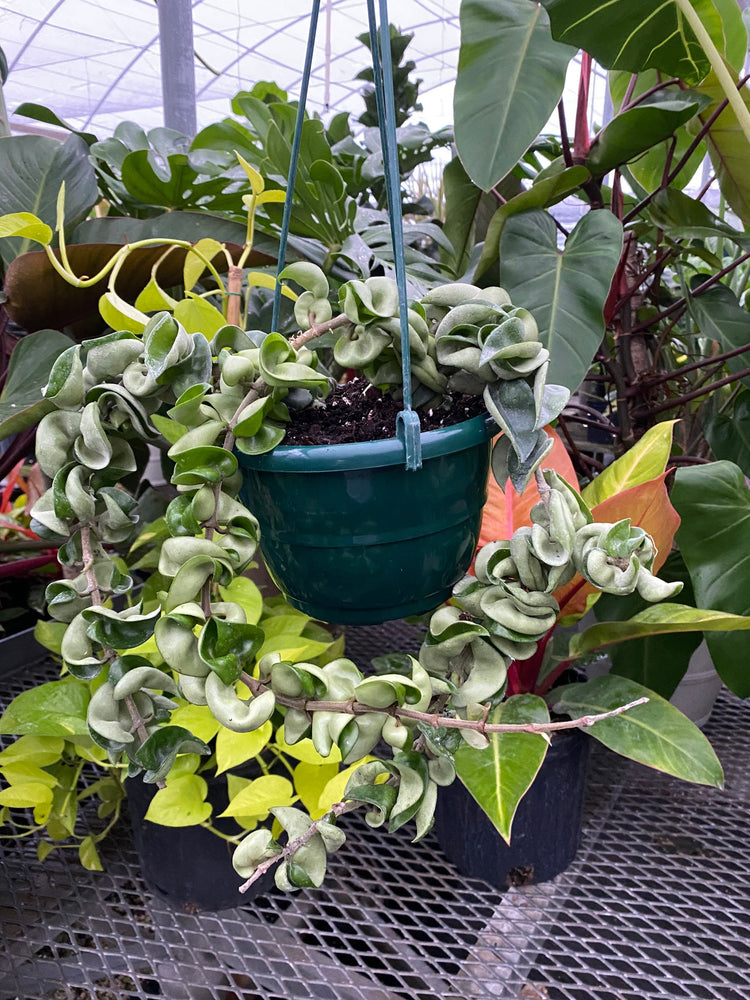
Botanical info: Hoya carnosa (wax plant) is a trailing / climbing perennial with thick, waxy leaves and clusters of star-shaped flowers.
- Light: Bright, indirect light is best for flowering.
- Water: Let the top of the soil dry slightly; hoyas prefer to be slightly pot-bound.
- Air quality: Studies have shown Hoya carnosa has air-purifying properties, removing some indoor pollutants.
- Styling tip: Use a hanging basket or macramé hanger so its twining / trailing stems can spread. Because it’s lightly rooted sometimes, use a well-aerated potting mix (perlite, pumice, etc.)
6. Fern Varieties (Ferns in Hanging Baskets)

Ferns are a classic choice for hanging planters, especially species that love humidity and trailing fronds.
- Kimberly Queen Fern (Nephrolepis obliterata)
- Lush lance-shaped fronds; more tolerant of light than some ferns.
- Soil: keep evenly moist.
- Light: bright but indirect.
- Styling: Use a deep basket; ferns like space for root spread.
- Asparagus Fern (Asparagus aethiopicus / foxtail fern)
- Feathery, airy foliage gives a soft, elegant drape.
- Water: moderate; don’t let it dry out fully.
- Humidity: enjoys humidity — mist occasionally.
- Staghorn Fern
- Not a typical soil fern; epiphytic in nature. Needs mounting or a specialised basket.
- Water: soak occasionally; high humidity is important.
- Styling: Mount on a piece of wood or use a moss-filled hanging basket.
7. Creeping Jenny (Lysimachia nummularia)

Why it’s great for hanging: Creeping Jenny is a trailing ground-cover plant with round, lime-green leaves and a lovely drape.
- Light: Grows in full sun to partial shade.
- Water: Likes moist soil and can tolerate more humidity.
- Special note: This plant can be invasive outdoors, so hanging baskets or containers are ideal for control.
- Styling tip: Use a basket with rich, fertile soil to let its foliage spill out beautifully.
8. Trailing Tradescantia (Wandering Jew)
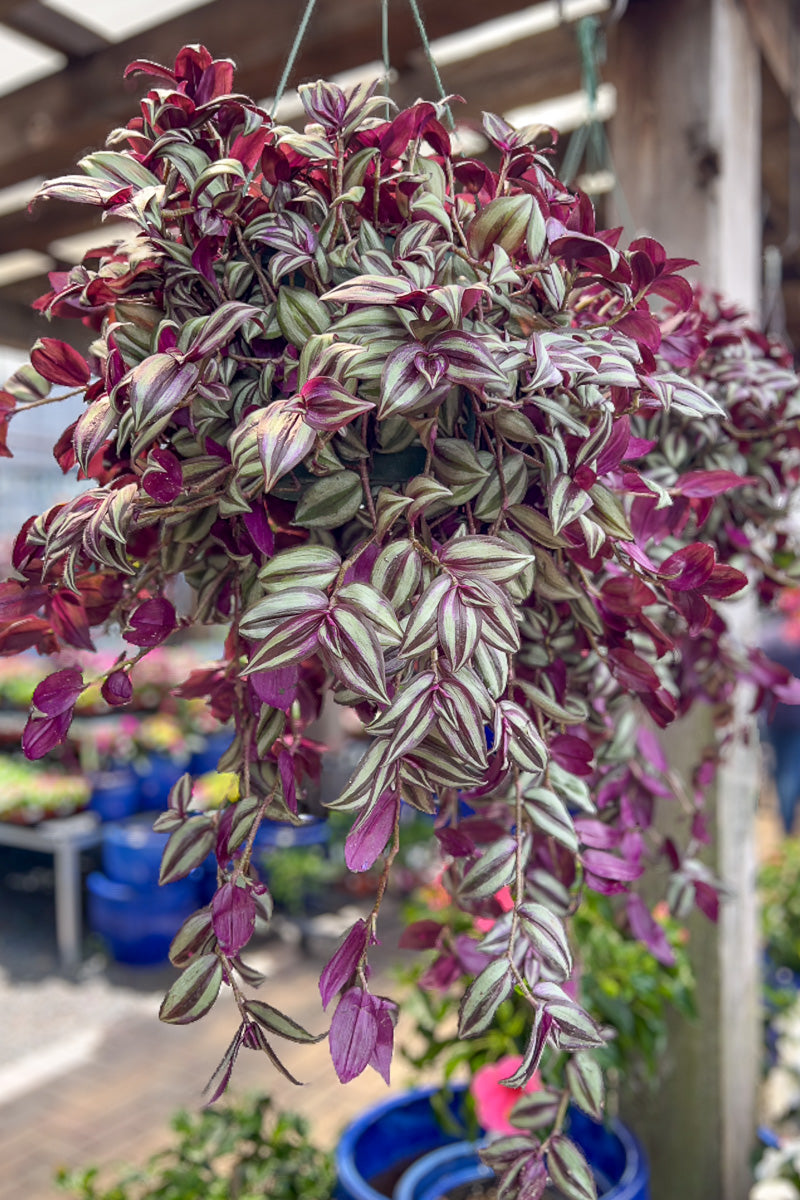
Care & growth: As per the Healthy Houseplants guide, trailing tradescantia varieties grow quickly, root easily from cuttings, and are very forgiving.
- Light: Prefer bright indirect light; some cultivars can tolerate moderate light.
- Water: Keep evenly moist, but don’t overwater.
- Propagation: Very easy — stem cuttings root both in water and soil.
- Styling tip: Because of its fast growth, place tradescantia in a hanging pot where the long stems can cascade freely.
9. Trailing Jade / Peperomia rotundifolia

Plant profile: Peperomia rotundifolia, also known as trailing jade, has small, round, fleshy leaves and trails beautifully.
- Light: Bright, indirect light works best.
- Water: Let the soil dry slightly between waterings; it doesn’t like soggy conditions.
- Soil: Well-draining potting mix — a mix for succulents or soilless mix works well.
- Styling tip: Use a shallow hanging pot to showcase its delicate trailing stems; ideal for macramé hangers or small baskets.
Styling Ideas for Hanging Plant Pots
Create a “green chandelier”
Group 3–5 hanging pots at different heights (using pothos, philodendron, and spider plant) for a dynamic cascading effect.
Mix textures
Combine delicate trailing succulents like String of Hearts with leafy ferns or Tradescantia in the same arrangement (if light and water needs align).
Use macramé hangers
These bring a boho-chic aesthetic, especially with trailing plants like Hoya or Philodendron.
Layer with wall-mounted plants
Use wall-mounted mounts for plants like staghorn ferns, and hang other plants from the ceiling to build a vertical garden.
Conclusion
If you’re building a hanging indoor garden, the plants listed above are some of the best for indoor hanging pots — combining aesthetics, care flexibility, and trailing habit. Whether you choose heartleaf philodendron, Pothos, String of Hearts, Hoya, ferns, or trailing succulents, there’s a plant to suit your space and style.
With the right lighting, soil, watering habits, and support system, you can create a thriving, eye-catching vertical plant display in your home.
You’re creating a sanctuary. A mood. A lifestyle.
And with the right hanging plants, that transformation begins the moment you hang the first pot.

